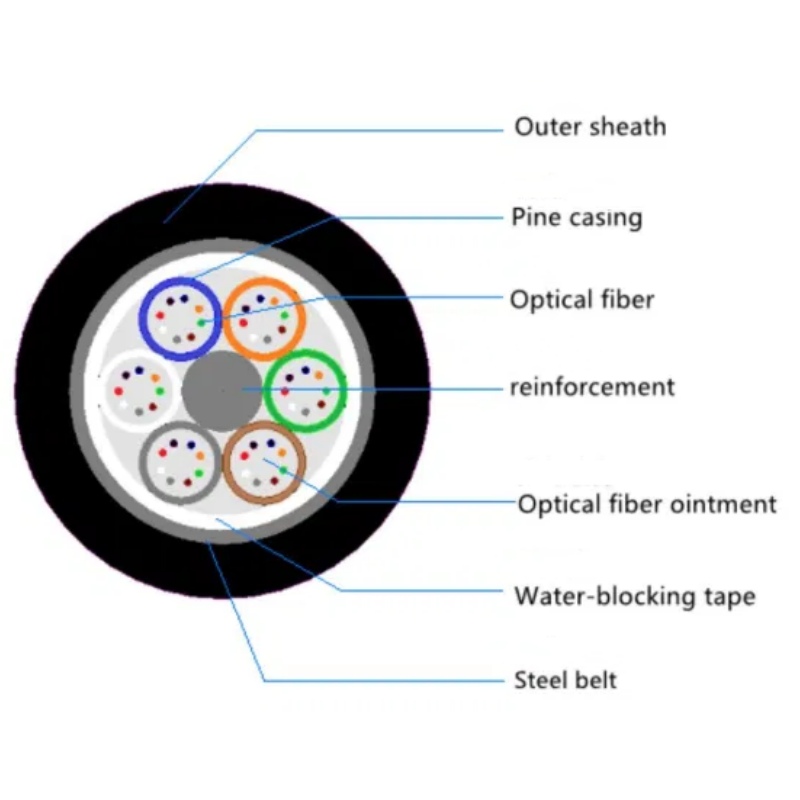Armored Fiber Optic Cable for Unparalleled Reliability Supplier
The main feature of armored optic cable is the presence of a metallic armor layer surrounding the optical fibers.
This armor layer provides physical protection and strength to the cable, making it more robust and able to withstand harsh conditions.
The armor layer is typically made of steel or aluminum, which adds an extra layer of protection against damage.

Armored optic cable is designed with additional protection to enhance its durability and resistance to external factors.
It commonly uses where the optic cable may be exposed to potential hazards, such as rodents, moisture, crushing or abrasion.
The armored construction of the cable offers several advantages
Enhanced Protection
The armored layer provides protection against rodents, pests, and other external threats that can potentially damage the optical fibers. It helps prevent fiber breaks and signal loss due to physical stress.
Crush and Impact Resistance
The armored layer adds strength to the cable, making it resistant to crushing or impact damage. This is particularly useful in industrial environments or areas with heavy machinery, where cables may be subjected to heavy loads or accidental impacts.
Abrasion Resistance
Armored optic cables are designed to withstand abrasion from rough surfaces or sharp edges. The armor layer acts as a barrier, protecting the delicate optical fibers from abrasion damage during installation, handling, or when routed through challenging pathways.
Flexibility and Bend Radius
Despite the added protection, armored cables still maintain a certain level of flexibility, allowing for ease of installation and routing. They can be bent and routed around corners without compromising the performance of the optical fibers.
Outdoor and Harsh Environments
Armored optic cables are suitable for outdoor installations or harsh environments where exposure to moisture, UV radiation, chemicals, or extreme temperatures is a concern.
The armor layer provides additional resistance to these environmental factors, ensuring the longevity and reliability of the cable.
Types of Armored Fiber Optic Cable
Indoor Armored Fiber Optic Cable
Indoor armored fiber optic cables can be categorized into single-armored and double-armored types.
The structure of a single-armored indoor cable consists of tight-buffered fibers, aramid yarn (providing tensile strength), stainless steel tubing (providing crush resistance, bending protection and protection against rodent bites), stainless steel braiding (providing torsion resistance) and an outer sheath (typically PVC, or flame-retardant PVC, LSZH, Teflon and silicone tubing due to specific needs).
Single-armored refers to cables without stainless steel braiding, while double-armored refers to cables with both stainless steel tubing and stainless steel braiding.
Advantages:
- High tensile strength and crush resistance
- Protection against rodent bites
- Resistant to improper twisting and bending damage
- Easy installation, lower maintenance costs
- Suitable for various harsh environments and protection against intentional damage
Disadvantages:
- Heavier than non-armored fiber optic cables
- Higher price compared to non-armored cables
Outdoor Armored Fiber Optic Cable
Outdoor armored fiber optic cables can be classified as light-armored and heavy-armored.
Light-armored cables may have steel or aluminum tape used for reinforcement and protection against rodent bites.
Heavy-armored cables have an additional layer of steel wire, typically used for riverbed or underwater installations.
Armored cables are generally more expensive than non-armored cables, with steel or aluminum tape being more affordable than aramid yarn (which is primarily used for special occasions).
Based on the metal armor material
Steel-armored: Typically in a bolt-like configuration, with a metal armor layer protecting the fiber core. These cables can naturally bend and offer excellent protection against high pressure and strong tensile forces.
Aluminum-armored: Similar to steel-armored cables, but with an aluminum armor layer instead. They provide similar protection but are generally less expensive.





